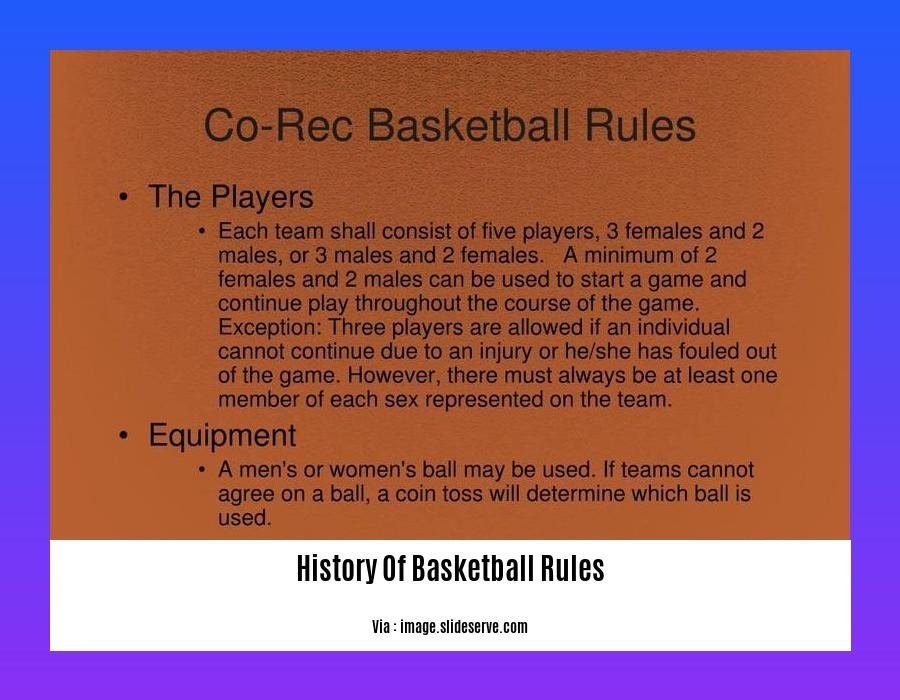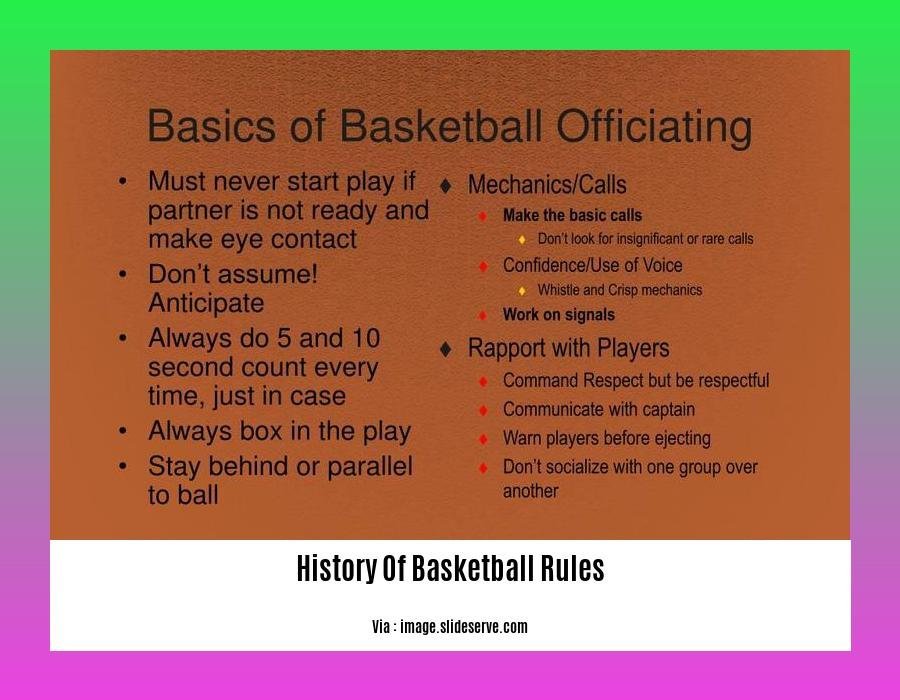Get ready to dive into the fascinating story of how basketball rules have changed over time! In this article, “The Evolution of Basketball Rules: A Journey Through History,” we’ll take a deep dive into the history of this beloved sport and explore how the rules have transformed it into the exciting game we know today. From the early days to the modern era, we’ll discover the key decisions that shaped basketball’s rules, strategies, and the unforgettable moments that have made it a favorite for millions of fans around the world.

History of Basketball Rules: A Journey of Evolution
Picture this: it’s a chilly winter day in 1891, and a guy named Dr. James Naismith is looking for a way to keep his bored gym class entertained. He comes up with a simple game using a ball, a basket, and some rules. Little did he know, he was about to create one of the most beloved sports on Earth!
The Evolution of the Rules:
Over the years, basketball has undergone some pretty significant rule changes. Here’s a quick rundown:
- Players and Positions: Dr. Naismith’s game had nine players on a team, with no specific positions. But by 1945, it was down to five players, with the familiar guard, forward, and center positions.
- Dribbling: Dribbling wasn’t always a thing. In fact, it was only introduced in 1901 to make the game more fast-paced.
- Shooting: Back in the day, basketball hoops were literally peach baskets. But in 1908, backboards were added to stop people from camping out under the hoop and blocking shots. And in 1979, the three-point shot came along to add some extra excitement.
- Fouls: Fouls weren’t always defined as clearly as they are now. Over time, the rules have been fine-tuned to include more subtle violations.
- Overtime: Tie games used to be a real bummer. But in 1936, overtime was introduced to give teams a chance to break the deadlock.
The Constant Evolution:
Basketball rules are always changing, and that’s what keeps the game fresh and exciting. Whether it’s tweaking the fouls or adjusting the gameplay, the goal is always to make the game more enjoyable for players and fans alike.
So, there you have it: the fascinating history of basketball rules. From its humble beginnings to its modern-day glory, this sport has come a long way in a relatively short amount of time. And who knows, maybe we’ll see even more rule changes in the future!
- Here you can find the whole story about how bachata dance came to be. Know more about the history of bachata dance.
- Get the full story of how bachata music got its name and where it came from. Check the history of bachata music now!
- For everything you ever wanted to know about badminton in the Philippines, learn the history of badminton in the Philippines today.
- Dive into the world of cinema and discover its rich history with our comprehensive history of cinema timeline.

How did the rule requiring players to pass the ball over the center line within 8 seconds evolve?
Picture this: a basketball game where teams could camp out in their own half of the court, dribbling the ball around and taking their sweet time. Not exactly the fast-paced, thrilling sport we know and love, right?
That’s why the 8-second violation came into play in the 1930s. It was like a shot of adrenaline for basketball, forcing teams to get moving and keep the action exciting.
Before this rule, games could drag on with teams deliberately stalling, trying to run out the clock. But with the 8-second violation, teams had to advance the ball past half-court within just 8 ticks of the clock. It was like a race against time, and it made the game so much more fun to watch.
Now, the 8-second violation might seem like a no-brainer, but it’s actually been a bit of a hot topic since the beginning. Some critics argue that it stifles creativity and prevents teams from slowing down the pace when necessary. Others maintain that it’s essential for keeping the game moving at a brisk clip.
Despite the debate, the 8-second violation has become an integral part of basketball, shaping the game into the fast-paced, high-scoring affair we enjoy today. It’s a rule that has stood the test of time and continues to make basketball one of the most exciting sports to watch.
Time Out: A Deeper Dive into the 8-Second Rule
- When does the 8-second clock start? As soon as a team gains possession of the ball.
- How long do teams have? 8 seconds to get the ball over the center line.
- What happens if a team violates the rule? The opposing team gets the ball back.
- Does the 8-second clock reset after a made basket? Yes, it starts over with each new possession.
When and How Was Dribbling Introduced in Basketball?
Imagine playing basketball without the ability to dribble. It would be a chaotic mess of players passing and bouncing the ball with no fluidity. That was the reality of basketball before dribbling changed everything in the late 1800s. So, let’s dive into the fascinating story of how dribbling became an integral part of the game.
In the early days of basketball, players could only pass the ball or shoot it. But in 1897, a small but significant rule change allowed players to bounce the ball once before passing it. This “one-bounce” rule created the foundation for the continuous dribbling that we’re familiar with today.
In 1901, the rules were further relaxed, allowing players to dribble the ball multiple times in a row. This opened up a whole new dimension to the game, giving players more control over the ball and allowing for faster, more dynamic play.
It all started with Yale University. In 1897, during a heated game against the YMCA, Yale’s Ossie Scheff decided to break the mold and bounce the ball several times before passing it. His bold move shocked the crowd and revolutionized the sport forever.
Here’s a simple timeline of the evolution of dribbling in basketball:
| Year | Rule Change |
|---|---|
| 1897 | One-bounce rule introduced |
| 1901 | Continuous dribbling legalized |
| 1897 | Yale University first team to dribble in a game |
So, there you have it. Dribbling, one of the most fundamental aspects of basketball, started as a small experiment and grew into an indispensable skill that transformed the game. And we have the ingenious minds at Yale University to thank for it.
What Motivated the Rule Change that Standardized the Number of Players on a Basketball Team?
Basketball in the olden days was a wild show, with a whopping nine players on the court for each team. It was like a crowd scene from a movie! The game was disorganized and confusing, making it hard for the refs to keep up, let alone for the fans to enjoy.
Then, one glorious day in 1893, the powers that be stepped in and made a smart move. They realized that nine was too many players, like trying to fit a whole pizza in your mouth at once. So, they sliced the number down to five per team, making it a much more manageable game.
What Changed?
- More Space, More Fun: With five players instead of nine, there was suddenly more room to move around. Players could dribble, pass, and shoot without constantly bumping into each other. This made the game faster and more exciting to watch.
- Strategy Time: Having fewer players on the court forced teams to think more tactically. They couldn’t just rely on having extra bodies to make up for mistakes. Teams started developing specific strategies, like zone defense and pick-and-rolls, to gain an edge.
- Equal Opportunity: With only five players per side, every player had a chance to shine. Gone were the days when some players just stood around waiting for the ball. Now, everyone could get involved and contribute to the team’s success.
In short, the standardization of player count revolutionized basketball. It turned it from a chaotic spectacle into an organized, strategic, and downright thrilling sport. So, next time you’re watching a basketball game and marveling at the skill and teamwork on display, give a little nod to the rule-makers of 1893 who made it all possible.
FAQ
Q1: Who invented the game of basketball and when was it invented?
A1: Basketball was invented by Dr. James Naismith in 1891.
Q2: What were the original 13 rules of basketball?
A2: The original 13 rules of basketball included guidelines on ball movement, scoring, fouls, and other aspects of the game.
Q3: How has dribbling evolved in the history of basketball?
A4: Initially not allowed, dribbling was introduced in 1901 with restrictions, and has since become an integral part of the game.
Q4: What was the first major rule change in basketball?
A5: Reducing the number of players from nine to five per side in 1893.
Q5: How did the shot clock impact the game of basketball?
A6: Introduced in 1954, the shot clock forced teams to shoot within a certain time period, leading to a faster-paced game.
- Explore Arkansas Map: Cities, Towns, Rivers & Mountains Now - March 28, 2025
- Discover Northern Pakistan’s Hidden Gems: Your Ultimate Guide - March 27, 2025
- Explore Eastern Canada: Unforgettable Adventures Await - March 27, 2025
















